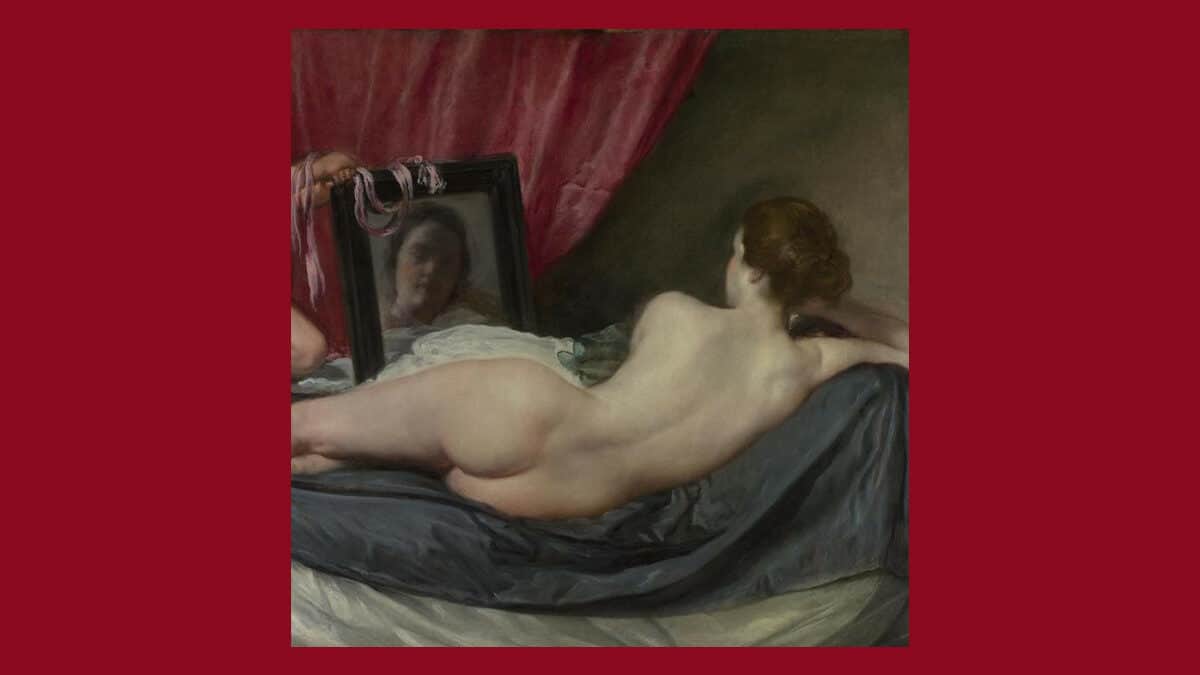It’s never good when a famous painting gets damaged! There are different types of damage that can affect paintings, some of them accidental, some intentional – such as the vandalism which affected The Rokeby Venus in 1914.
A lot of the work done here at National Gallery is actually repairing the damage to paintings. There is a painting that was very difficult for the gallery to fix!
If you’ve heard of Roman Mythology, you’ll have heard about Venus. Venus is a Roman Goddess who appears in a lot in paintings from over the centuries. She was the most beautiful woman in the universe – she’s often pictured laying in bed or on some rocks, staring in a mirror to see how lovely she’s looking. The Rokeby Venus is a painting which shows just that – it was created by the Spanish painter Velazquez around 1650.
In 1914 the painting was vandalised – which means it was damaged on purpose. A woman called Mary Richardson, who was protesting for women’s right to vote, sneaked a knife into the gallery and when the curators weren’t looking, she slashed the canvas 15 times making deep cuts on Venus’s back!
But if you look at the painting today, you’ll have to really struggle to see where those cuts were because the expert restorers have made a perfect repair. People damaging paintings on purpose is pretty rare but it does happen. Whatever the damage, before experts can start repairing a picture, they’ll need to know what caused the damage. Sometimes, that can take quite a bit of detective work to figure it out!
Some damage is accidental. For example, tears and rips can be caused if paintings are moved without care. Some damage is just caused by time. Paints can fade and even appear to be a different colour as the decades and centuries pass by. Paints can even begin to flake and crack which can make a pattern of lines over the picture, or the paint can begin to lift off entirely!
Other times paintings are just plain dirty – it could be they’ve been stored somewhere smoky or even outside, sometimes for hundreds of years. Other damage is caused by things around the painting – weather is a big one!
A rain–soaked canvas can become distorted, as can one which has been somewhere too hot or steamy. Animals or insects might enjoy taking a nibble too – and as we’ve found out, bat poo caused streaks to appear on one famous painting which had been stored in a castle. Click here to find out what happened to The Adoration of the Shepherds!
Damage can even be caused by people trying to be helpful! Scrubbing away at the surface or rubbing soaps or cleaning products in might seem like a good idea to make a picture clearer – but unless you know what you’re doing… well you might scrub away half the paint!
And that’s where the experts come in. They can analyse the painting and the damage to figure out what’s happened. Then they can put things right – without making things worse!
Have a go at repairing a piece of art!
Can you imagine how you would repair a big painting?
You’ve probably accidentally ripped a painting you’ve made at school before. Try printing off a painting from your computer, tearing it, and repairing it and see how you can get it back looking the same as it did before it was damaged.
How would you start?
On a real painting like this one, you’d have to start very gently, cleaning the layers of dirt and varnish first before you start painting. And if it’s torn, you’d need to find a way to stick it back together without being able to see.
Be careful though!
You’d want to get the dirt off when you’re cleaning, not the paint! Some paints have different “thinners” – watercolours are soluble in water, oil paints are soluble in solvents etc, so you’d need to be careful not to move the paint around by accident.
How would you get the painting looking as it was before it was painted?
A great deal of time and work goes into restoring paintings so they look exactly as they did when they were first painted. It takes years of training to get it all right! There was one lady in Spain a few years ago who tried to restore a painting in her local church herself. Click here to see what happened!





